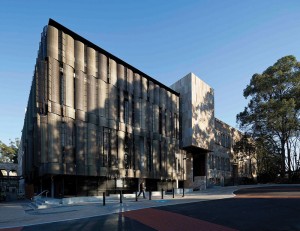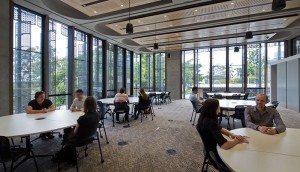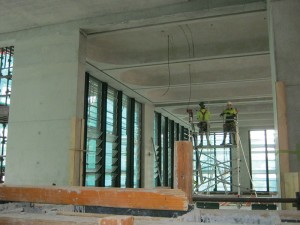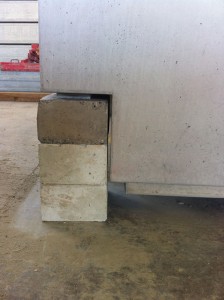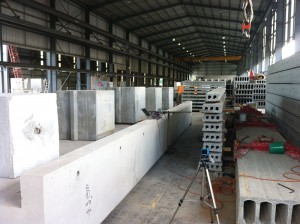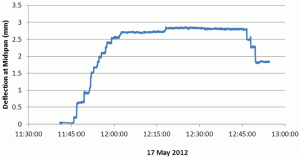The Global Change Institute (GCI) is an Australian organization within The University of Queensland (UQ) that researches global sustainability issues including resource security, ecosystem health, population growth and climate change (Figure 1). The design of its new $32 million (AUD) building by project architects, HASSELL and structural and façade engineers, Bligh Tanner, was to be an exemplar project benchmarked using the Green Building Council of Australia’s Green Star rating (at 6 Star Green Star level), as well achieving an Australian-first Living Building Challenge compliance. The Living Building Challenge is an international rating system based in North America that explores a broader basis of sustainability, assessing the seven performance areas of site, water, energy, health, materials, equity and beauty. Further design parameters set for the project were zero net carbon emission for building operation, carbon neutral with carbon offset.
Design process
Early in the design, the structural engineering team explored the potential for the incorporation of structural timber. The work at the University of Technology, Sydney, developing and testing Timber-Concrete Composite (TCC) floors, was of interest and was proposed as a potential floor system that combined the benefits of timber framing with the acoustic, fire separation and wearing properties of concrete (Figure 2). It was at this stage that the strong potential for use of geopolymer concrete in the system was identified, as the structural topping would be working at low stress and precasting of the TCC panels would enable quality control in a factory environment. Use of precast was also recognized as advantageous considering the very limited site.
The design of the passive and low energy thermal control systems was developing at the same stage, and was pushing the floor systems toward high thermal mass with active heat exchange by the pumping of air or water through a concrete slab system. The next logical iteration of the design was to precast geopolymer concrete floor panels with incorporated hydronic pipes coils. To maximize the effectiveness of the radiant heat transfer from the concrete, the soffit needed to be exposed with maximum surface area. This then led to the development of vaulted soffit panels, which were both visually appealing, of high thermal efficiency and reflected light down onto functional spaces (Figure 3). Suspended ceiling panels contained lighting, communication technology and sprinklers. Various forms of the 11-meter-span (36-foot) panels were explored, which allowed for air distribution in a plenum/services void above the panels. The exposed concrete frame, which supports the precast geopolymer concrete panels, was designed to incorporate the air distribution system, which supplies the plenum.
Bligh Tanner made contact with Wagners who were developing a geopolymer concrete product branded Earth Friendly Concrete (EFC). Wagners had undertaken some preliminary testing at the time to produce an initial summary engineering report that would ultimately lead to further verification testing for compliance with AS3600 (Australian Standard for Concrete Structures). Although the use of geopolymer was so novel that it would not gain any additional Green Star points in the Material category, The University of Queensland, as the client, understood the significance of the innovation which went beyond Green Star rating. Wagners were asked to fast track the reporting and testing, with a critical cut off date for the interim research report to be indicating whether or not the use of geopolymer concrete on the project was viable. The Green Star submission, which is currently being assessed, includes two Innovation points for the use of the geopolymer concrete on the basis of being a world-first innovation and exceeding the Green Star benchmarks. A positive interim report was delivered during the design period. The only issue identified as a potential concern relative to normal concrete was carbonation resistance; however, this was not considered to be of significance in this case as it was for internal use only. Subsequent testing has shown that rate of carbonation for the mix design adopted is similar to normal concrete incorporating blended cement. At this point, the project consultants accepted geopolymer concrete as the preferred option for the precast floor beams used in the three suspended floors.
An additional concern was the ability to supply the geopolymer concrete to the precast fabricator, and also for the precast fabricator, to be willing to take on the risk of working with a new product. The design team and Wagners worked closely with Precast Concrete to ensure that the process was feasible. Bligh Tanner stipulated that a full-scale load test (up to maximum working load) could be undertaken on a panel to confirm the strength and deflection were as predicted. This was considered prudent given the world-first application of modern geopolymer concrete for suspended construction.
Compliance Testing
Geopolymer concrete was included in the design for the 33 precast floor beams (320m3 ≈ 419 c.y.) that formed three suspended floors in the building. The specification for the geopolymer concrete in these beams relied on:
- Testing key material properties referenced in AS3600.
- Independent engineering verification that the tested results showed structural performance properties equivalent to the design basis for design reinforced concrete dicated in AS3600.
All tests were undertaken by Wagners Technical services, in some cases using external laboratories (Figure 4). The results were independently assessed by Dr James Aldred of AECOM, who Wagners commissioned to provide the independent certification on the geopolymer concrete. Test samples, with the exception of creep and the fire and load tests, were cast and made from geopolymer concrete used during the supply phase of the project. The relevant Australian Standard test method was used in all cases. Creep was assessed via full scale prestressed beams which were made in 2010 and were monitored under load via the use of internal vibrating wire strain gauges. A fire test was conducted at the CSIRO fire testing station at North Ryde, Sydney prior to the start of the project.
The first floor beam panel produced served as the prototype to be load tested. Figure 5 shows that the measured deflection under an equally distributed 10 ton load was 2.85 mm (0.10 inches), slightly less than the predicted 3mm using an uncracked section analysis.
The testing program revealed a number of beneficial properties of the geopolymer concrete compared to normal GP based concrete, most notably:
- Half the typical 56 day drying shrinkage, at an average value of 320 microstrains
- 30% higher flexural tensile strength than a comparison standard concrete
- Extremely low heat of reaction
These properties would indicate that an improved level of performance would be achieved in a range of typical structural applications.
Practical Aspects
Apart from the design and specification details, the geopolymer concrete was required to meet all of the usual handling requirements involved in batching and delivering concrete. Based on several years of EFC supply to a range of external projects and trials, Wagners were able to demonstrate that the geopolymer concrete could be handled and finished similarly to normal concrete. In the case of filling and compacting precast moulds, the methods are the same (Figure 6). Loads can be batched with all ingredients except the activating chemicals and transported for up to 12 hours to a remote destination in a completely dormant non-reactive state. At the destination, the chemicals are added in a dry powder form directly into the Agitator bowl and mixed on site.
While EFC can be produced in normal concrete batching facilities, it is a requirement that GP cement does not contaminate the mix because it causes rapid setting, particularly at higher temperatures. If weigh bins and the like are shared with normal concrete production in a batch plant, then it is possible that the fines of GP cement dust will enter the EFC geopolymer mix in enough quantity to cause variable set times.
Another beneficial aspect of geopolymer concrete is its natural off-white finish, is considered a desirable architectural feature. The finished precast geopolymer beams were installed into the building structure during the period of August to October 2012 (Figure 7).
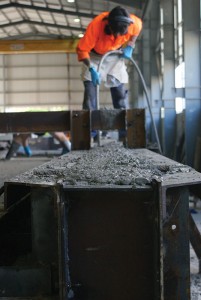
Figure 7: EFC geopolymer concrete being vibrated into the beam molds, at Precast Concrete Pty Ltd factory, Brisbane.
Following installation, the precast geopolymer beams were sealed. Several patch trials were carried out to ensure compatibility between the geopolymer concrete and proprietary sealers.
Conclusion
Geopolymer concrete has now moved beyond an emerging technology into the space of a structural concrete that can be designed and used in structures and other applications, as long as the necessary verification and testing is undertaken. The term geopolymer is very broad and encompasses a range of different concretes which may have quite different structural properties. The proprietary geopolymer concrete used in the Global Change Institute building proved to be fully compliant with the structural performance parameters that AS3600 is based on.
The use of geopolymer concrete in the multi-storey Global Change Institute building provides an example of how a medium sized engineering consultancy went about assessing a new technology’s ‘fit for purpose’ suitability. It is hoped that this example may provide a path for others to explore new and innovative approaches to structures that improve the sustainability of our built environment. In association with a range of other sustainability innovations utilized in this building, the geopolymer concrete floor beams help to make the Global Change Institute building an outward expression of its inner purpose.▪
A similar article was presented at the Concrete 2013 Conference, October 2013 in Queensland, Australia. It was also used as a reference document for media releases and other media articles.

